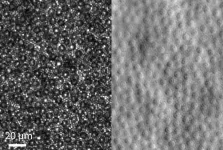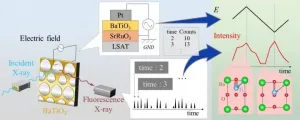(Press-News.org) A team led by scientists at the National Eye Institute (NEI) has noninvasively visualized the light-sensing cells in the back of the eye, known as photoreceptors, in greater detail than ever before. Published in Optica, the researchers report how they improved imaging resolution by a third by selectively blocking the light used to image the eye. NEI is part of the National Institutes of Health.
The achievement is the latest in an evolving strategy to monitor cell changes in retinal tissue that, in turn, will help identify new ways to treat and prevent vision loss from diseases such as age-related macular degeneration, a leading cause of blindness in people age 65 and older.
"Better imaging resolution will enable better tracking of degenerative changes that occur in retinal tissue. The goal of our research is to discern disease-related changes at the cellular level over time, possibly enabling much earlier detection of disease," said the study's lead investigator, Johnny Tam, Ph.D., Stadtman Investigator in the Clinical and Translational Imaging Unit at NEI.
Earlier detection would make it possible to treat patients sooner, well before they've lost vision. What's more, detecting cellular changes would enable clinicians to more quickly determine whether a new therapy is working.
The two types of photoreceptors, cones, which enable color vision, and rods, which enable low-light vision, vary in size and density across the retina. Cone photoreceptors, while larger than rods, are trickier to visualize when they're more tightly packed together as they are in the fovea, the region of the retina responsible for the highest level of visual acuity and color discrimination. The entire landscape of cones and rods is referred to as the photoreceptor mosaic.
Advanced imaging systems are widely used for observing retinal tissue and are essential tools for diagnosing and studying retinal diseases. But even with adaptive optics retinal imaging, a technique that compensates for light distortions using deformable mirrors and computer-driven algorithms, there are still some areas of the photoreceptor mosaic that are challenging to image, according to the first author of the paper, Rongwen Lu, Ph.D., a postdoctoral fellow in the Clinical and Translational Imaging Unit at NEI.
"Sometimes rods are hard to image because they are so small," Lu said. "By eliminating some of the light in the system, it actually makes it easier to see the rods. So in this case, less is more."
In this latest report, Tam's team at NEI, with help from researchers at Stanford University, Palo Alto, California, sought to push the resolution of adaptive optics retinal imaging further by strategically blocking some of the light to image the retina.
By blocking the light that illuminates the eye in the middle of the beam, to create a ring of light (rather than a disk), the NEI-led team improved the transverse resolution (across the mosaic). But that came at the expense of axial resolution (mosaic depth). To compensate, Tam's team blocked the light coming back from the eye using a super small pinhole, called a sub-Airy disk, which recovers the axial resolution that would have been lost using the ring of light alone.
Combining the ring illumination with the sub-Airy disk imaging results in the best of both worlds, Tam said. The tweaked technique yields about a 33% increase in resolution, which makes it much easier to see rods, as well as subcellular details within cones.
Their technique also enhanced the visualization of the photoreceptor mosaic with another technique called non-confocal split-detection, which is yet another type of microscopy that provides a complementary view of the photoreceptor mosaic.
INFORMATION:
The work was supported in part by NEI grants U01 EY025477 and R01 EY025231, and by the Intramural Research Program at the NEI, part of the National Institutes of Health.
References:
Lu R, Aguilera N, Liu T, Liu J, Giannini JP, Li J, Bower AJ, Dubra A, Tam J. "In vivo sub-diffraction adaptive optics imaging of photoreceptors in the human eye with annular pupil illumination and sub-Airy detection," published March 11, 2021, Optica.
NEI leads the federal government's research on the visual system and eye diseases. NEI supports basic and clinical science programs to develop sight-saving treatments and address special needs of people with vision loss. For more information, visit https://www.nei.nih.gov.
About the National Institutes of Health (NIH): NIH, the nation's medical research agency, includes 27 Institutes and Centers and is a component of the U.S. Department of Health and Human Services. NIH is the primary federal agency conducting and supporting basic, clinical, and translational medical research, and is investigating the causes, treatments, and cures for both common and rare diseases. For more information about NIH and its programs, visit https://www.nih.gov/.
NIH...Turning Discovery Into Health®
DALLAS, March 11, 2021 -- Non-O blood type may increase the risk of stroke among women who smoke and take oral contraceptives, according to preliminary research to be presented at the American Stroke Association's International Stroke Conference 2021. The virtual meeting is March 17-19, 2021 and is a world premier meeting for researchers and clinicians dedicated to the science of stroke and brain health.
According to the most recent comprehensive data (January 2020) from the Centers for Disease Control and Prevention (CDC), stroke is the fifth leading cause of death in the United States and a major contributor to long-term disability. Some risk factors ...
Rainbows are some of the most spectacular optical phenomena in the natural world and Hawai'i has an amazing abundance of them. In a new publication, an atmospheric scientist at the University of Hawai'i at Mānoa makes an impassioned case for Hawaii being the best place on Earth to experience the wonder of rainbows. He begins by highlighting the Hawaiian cultural significance of rainbows, he reviews the science of rainbows and the special combination of circumstances that makes Hawai'i a haven for rainbows.
"The cultural importance of rainbows is reflected in the Hawaiian language, which has many words and phrases to describe the variety of manifestations in Hawai'i," said author Steven Businger, professor in the UH ...
DALLAS, March 11, 2021 -- Stroke patients were nearly 50% more likely than heart attack patients to develop depression, and female stroke patients had a higher risk of depression than their male counterparts, according to two preliminary studies by the same research group to be presented at the American Stroke Association's International Stroke Conference 2021. The virtual meeting is March 17-19, 2021 and is a world premier meeting for researchers and clinicians dedicated to the science of stroke and brain health.
In what researchers described as one of the largest ...
Researchers in Japan have used a novel, ultra-fast technique to explore the fine structure of a potential alternative material to lead titanate, a ferroelectric material widely used for sensors in many everyday devices. Understanding this structure takes us a step closer to eliminating these remaining sources of lead pollution.
The study appeared in the materials science journal Acta Materialia on 21 January.
Ferroelectric materials are used in a wide range of practical applications, from capacitors to memory cells, medical ultrasound to data storage and displays. These materials have a spontaneous polarization, or direction, of their electrons that can be switched back and forth via the application of an electric field, called ferroelectricity.
Worldwide, society is increasingly ...
DALLAS, March 11, 2021 -- When NA1, a neuroprotectant, was delivered to the brain in nanoparticles, it reduced stroke severity and improved survival in a mouse model of stroke, according to preliminary research to be presented at the American Stroke Association's International Stroke Conference 2021. The virtual meeting is March 17-19, 2021 and is a world premier meeting for researchers and clinicians dedicated to the science of stroke and brain health.
In an earlier human trial (the ESCAPE-NA1 trial), NA1, a small peptide designed to save brain cells from death after stroke, showed mixed results when NA1 was administered to patients undergoing clot removal for severe ...
DALLAS, March 11, 2021-- Stroke survivors may be more likely to attempt or die by suicide than people who have not had a stroke, according to preliminary research to be presented at the American Stroke Association's International Stroke Conference 2021. The virtual meeting is March 17-19, 2021 and is a world premier meeting for researchers and clinicians dedicated to the science of stroke and brain health. This study will be simultaneously published in the American Heart Association's journal Stroke.
Rates of depression among stroke survivors range from 28% to 35%, and stroke is considered an independent risk factor for depression. Since depression after a stroke has been associated with increased suicidal ...
Contains updated information not available in the abstract.
DALLAS, March 11, 2021 -- Having an ischemic stroke increases dementia risk, and that risk escalates with the number and severity of strokes, according to preliminary research to be presented at the American Stroke Association's International Stroke Conference 2021. The virtual meeting is March 17-19, 2021 and is a world premier meeting for researchers and clinicians dedicated to the science of stroke and brain health.
Ischemic stroke is the most common stroke type, accounting for 87% of all strokes. It occurs when a vessel supplying blood to the brain is obstructed. Stroke is the leading preventable cause ...
DALLAS, March 11, 2021 — For every 10-minute delay between arrival at the emergency room (ER) and starting stroke treatment, patients with severe strokes may lose eight weeks of healthy life, according to preliminary research to be presented at the American Stroke Association’s International Stroke Conference 2021. The virtual meeting is March 17-19, 2021 and is a world premier meeting for researchers and clinicians dedicated to the science of stroke and brain health.
Delays between the onset of stroke symptoms and arrival at the hospital have long been known to cost lives and brain cells.
“Our study showed that delays in treatment at the hospital ...
DALLAS, March 11, 2021 — Pictures of the retina may someday provide early warning signs that a person is at an increased risk of stroke and dementia, making it possible to take preventive measures, according to preliminary research to be presented at the American Stroke Association’s International Stroke Conference 2021. The virtual meeting is March 17-19, 2021 and is a world premier meeting for researchers and clinicians dedicated to the science of stroke and brain health.
Studies have shown that people with severe retinopathy, damage to the light-sensing ...
DALLAS, March 11, 2021 -- Discriminatory housing policies that restricted the sale or purchase of homes by race in certain neighborhoods across the U.S., called 'redlining,' which were established nearly a century ago and outlawed by the Fair Housing Act of 1968, were associated with higher rates of stroke in the same neighborhoods in 2017, according to preliminary research to be presented at the American Stroke Association's International Stroke Conference 2021. The virtual meeting is March 17-19, 2021 and is a world premier meeting for researchers and clinicians dedicated to the science of stroke and brain health.
"Differences in stroke rates, whether we are studying ischemic or hemorrhagic stroke, ...


